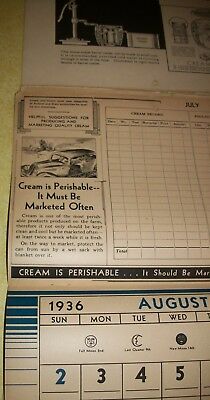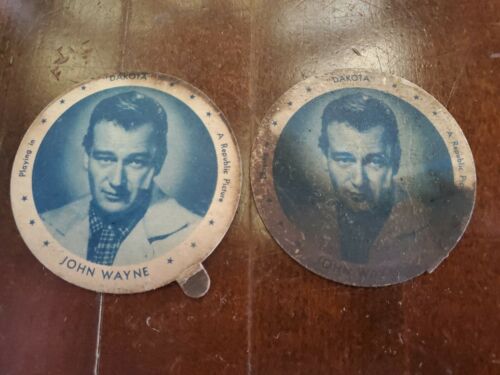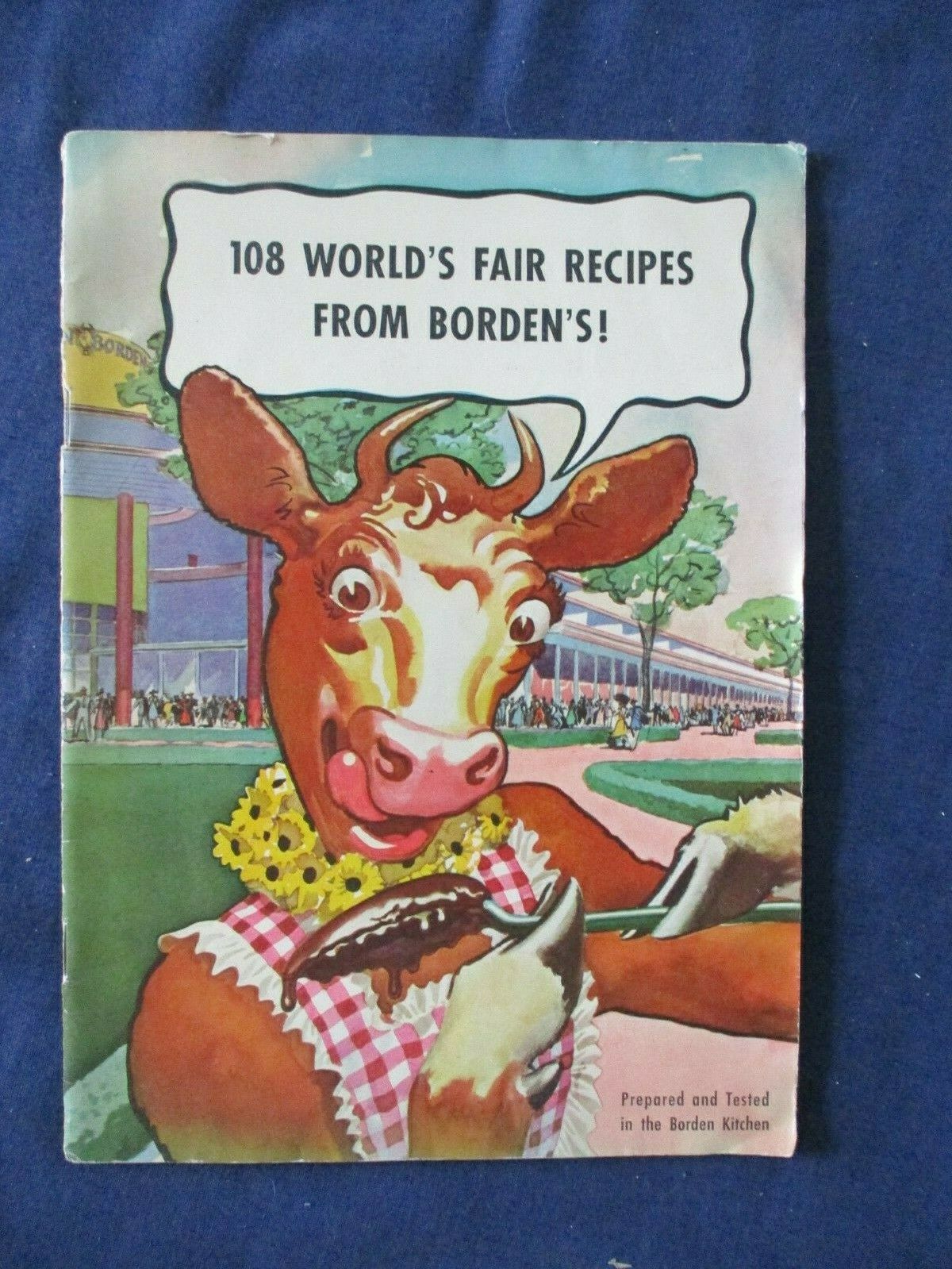-40%
OLD FAIRMONT CREAMERY CHRISTMAS CALENDAR PITTSBURGH ICE CREAM DAIRY 1936 PAPER
$ 22.81
- Description
- Size Guide
Description
OLD FAIRMONT CREAMERY CHRISTMAS CALENDAR PITTSBURGH ICE CREAM DAIRY 1936 PAPEROLD FAIRMONT CREAMERY CHRISTMAS CALENDAR PITTSBURGH ICE CREAM DAIRY 1936 PAPER
OLD FAIRMONT CREAMERY CHRISTMAS CALENDAR PITTSBURGH ICE CREAM DAIRY 1936 PAPER
Click image to enlarge
Description
GREETINGS, FEEL FREE
TO
"SHOP NAKED"
©
We deal in items we believe others will enjoy and want to purchase.
We are not experts.
We welcome any comments, questions, or concerns.
WE ARE TARGETING A GLOBAL MARKET PLACE.
Thanks in advance for your patronage.
Please Be sure to add WDG to your
favorites list
!
NOW FOR YOUR VIEWING PLEASURE…
OLD PAPER CALENDAR
1936 - 1937
THE FAIRMONT CREAMERY COMPANY
FIFTY TWO YEARS OF DEPENDABLE MARKETING SERVICE
PITTSBURGH, PENNSYLVANIA (PA)
DEPRESSION ERA / WWII AMERICANA
BRIGHT COLORS
SEPIA ILLUSTRATIONS
HELPFUL SUGGESTIONS
MEASURES ABOUT 9" X 7" CLOSED
STAPLE BINDING
SOME FOXING / TEARS
OTHERWISE GOOD
FYI
---------------------
A dairy is a building used for the harvesting of animal milk—mostly from cows or goats, but also from buffalo, sheep, horses or camels —for human consumption. A dairy is typically located on a dedicated dairy farm or section of a multi-purpose farm that is concerned with the harvesting of milk.
Terminology differs between countries. For example, in the United States, a farm building where milk is harvesting is often called a milking parlor. In New Zealand such a building is historically know as the milking shed - although in recent years there has been a progressive change to call such a building a farm dairy.
In some countries, especially those with small numbers of animals being milked, as well as harvesting the milk from an animal, the dairy may also process the milk into butter, cheese and yoghurt, for example. This is a traditional method of producing specialist milk products, especially in Europe. In the United States a dairy can also be a place that processes, distributes and sells dairy products, or a room, building or establishment where milk is stored and processed into milk products, such as butter or cheese. In New Zealand English the singular use of the word dairy almost exclusively refers to the corner convenience store, or superette. This usage is historical as such stores were a common place for the public to buy milk products.
As an attributive, the word dairy refers to milk-based products, derivatives and processes, and the animals and workers involved in their production: for example dairy cattle, dairy goat. A dairy farm produces milk and a dairy factory processes it into a variety of dairy products. These establishments constitute the dairy industry, a component of the food industry.
History
Milk producing animals have been domesticated for thousands of years. Initially, they were part of the subsistence farming that nomads engaged in. As the community moved about the country, their animals accompanied them. Protecting and feeding the animals were a big part of the symbiotic relationship between the animals and the herders.
In the more recent past, people in agricultural societies owned dairy animals that they milked for domestic and local (village) consumption, a typical example of a cottage industry. The animals might serve multiple purposes (for example, as a draught animal for pulling a plough as a youngster, and at the end of its useful life as meat). In this case the animals were normally milked by hand and the herd size was quite small, so that all of the animals could be milked in less than an hour—about 10 per milker. These tasks were performed by a dairymaid (dairywoman) or dairyman. The word dairy harkens back to Middle English dayerie, deyerie, from deye (female servant or dairymaid) and further back to Old English dæge (kneader of bread).
With industrialisation and urbanisation, the supply of milk became a commercial industry, with specialised breeds of cattle being developed for dairy, as distinct from beef or draught animals. Initially, more people were employed as milkers, but it soon turned to mechanisation with machines designed to do the milking.
Historically, the milking and the processing took place close together in space and time: on a dairy farm. People milked the animals by hand; on farms where only small numbers are kept, hand-milking may still be practiced. Hand-milking is accomplished by grasping the teats (often pronounced tit or tits) in the hand and expressing milk either by squeezing the fingers progressively, from the udder end to the tip, or by squeezing the teat between thumb and index finger, then moving the hand downward from udder towards the end of the teat. The action of the hand or fingers is designed to close off the milk duct at the udder (upper) end and, by the movement of the fingers, close the duct progressively to the tip to express the trapped milk. Each half or quarter of the udder is emptied one milk-duct capacity at a time.
The stripping action is repeated, using both hands for speed. Both methods result in the milk that was trapped in the milk duct being squirted out the end into a bucket that is supported between the knees (or rests on the ground) of the milker, who usually sits on a low stool.
Traditionally the cow, or cows, would stand in the field or paddock while being milked. Young stock, heifers, would have to be trained to remain still to be milked. In many countries, the cows were tethered to a post and milked. The problem with this method is that it relies on quiet, tractable beasts, because the hind end of the cow is not restrained.
In 1937, it was found that bovine somatotropin (bST or bovine growth hormone) would increase the yield of milk. Monsanto Company developed a synthetic (recombinant) version of this hormone (rBST). In February 1994, rBST was approved by the Food and Drug Administration (FDA) for use in the U.S. It has become common in the U.S., but not elsewhere, to inject it into milch kine dairy cows to increase their production by up to 15%.
However, there are claims that this practice can have negative consequences for the animals themselves. A European Union scientific commission was asked to report on the incidence of mastitis and other disorders in dairy cows, and on other aspects of the welfare of dairy cows. The commission's statement, subsequently adopted by the European Union, stated that the use of rBST substantially increased health problems with cows, including foot problems, mastitis and injection site reactions, impinged on the welfare of the animals and caused reproductive disorders. The report concluded that on the basis of the health and welfare of the animals, rBST should not be used. Health Canada prohibited the sale of rBST in 1999; the recommendations of external committees were that, despite not finding a significant health risk to humans, the drug presented a threat to animal health and, for this reason, could not be sold in Canada.
(THIS PICTURE FOR DISPLAY ONLY)
---------------------------
Thanks for choosing this auction. You may email for alternate payment arrangements. We combine shipping. Please pay promptly after the auction. The item will be shipped upon receipt of funds. WE ARE GOING GREEN, SO WE DO SOMETIMES USE CLEAN RECYCLED MATERIALS TO SHIP.
Please leave feedback when you have received the item and are satisfied. Please respond when you have received the item.
*****
5*'s
*****
If you were pleased with this transaction, please respond with all 5 stars! If you are not pleased, let us know via e-mail. Our goal is for 5-star service. We want you to be a satisfied, return customer.
Please express any concerns or questions. More pictures are available upon request. The winning bid will incur the cost of S/H INSURED FEDEX OR USPS. See rate calculator or email FOR ESTIMATE. International Bidders are Welcome but be mindful if your country is excluded from safe shipping.
Thanks for perusing
THIS
and
ALL
our auctions.
Please Check out our
other items
!
WE like the curious and odd.
BUY, BYE!!
Get images that
make Supersized seem small.
Showcase your items with Auctiva's
Listing Templates!
THE simple solution for eBay sellers.
Track Page Views With
Auctiva's FREE Counter


















